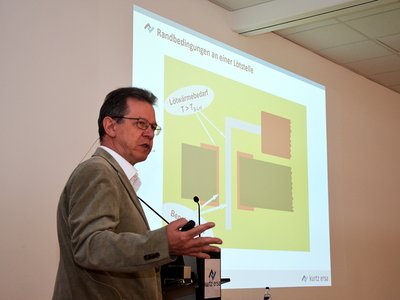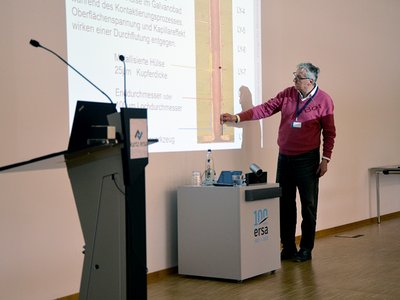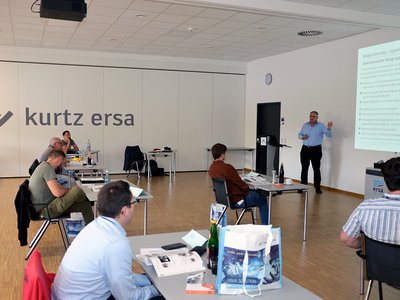Three proven experts in electronics production were recruited as speakers to vividly convey the complex subject matter: Arnold Wiemers, Technical Director of LeiterplattenAkademie GmbH from Berlin, Helge Schimanski, Group Manager Module Services at Fraunhofer ISIT, and Jürgen Friedrich, Head of Application Technology at Ersa GmbH, who introduced the topic at the start. Although all of them have been deeply involved in the topic for many years, even experts like the three speakers keep encountering new challenges in module production that need to be overcome. As broad as the field of participants at the event was, they all agreed on the common goal – "production of high-quality assemblies in all fields of application on an economical basis, which later reliably perform their service in the field". To achieve this, one first needs a design suitable for production and flexible production lines in the appropriate environment in order to be able to manufacture large series as well as small batch sizes efficiently and in top quality.
"In special areas such as e-mobility or space travel, an assembly is scrutinized and tested down to the smallest detail, precisely because very high demands are placed on the application, which takes place under a wide variety of climatic conditions – a repair in space, for example, is quite conceivable, but this is associated with astronomical costs," said Jürgen Friedrich. Complex quality factors must therefore be taken into account in assembly production in order to achieve a reproducibly flawless result within a defined process window – thermally and chemically – that also meets the physical boundary conditions in terms of material mix (metal, plastic, ceramic). Important quality factors to be considered are therefore: PCB, components, operator, process, equipment and environment – a soldering machine, however good the hardware, is not yet a guarantee of success.
Influences of individual work steps on the manufacturability and reliability of electronic assemblies in design, production and testing were shown – for example, the effect of the LP layout on the solder penetration of THT components or the dependence of subsequent reliability on the design of the PCB. Recommendations were made on how to design electronic assemblies with manufacturing considerations in mind, how to select materials and components, and how to evaluate manufacturing processes. "An optimal PCB layout is the foundation for producing high-performance, reliable PCBs. Quality starts in design – it pays to build up know-how here," emphasized Jürgen Friedrich.
Arnold Wiemers, Technical Director of the PCB Academy in Berlin, took over directly with his remarks on basic materials, CAD design and PCB technology. "For the production of electronic systems, the three disciplines of CAD design, PCB production and assembly production must work in coordination with each other," explained the proven PCB expert, who considers forward-looking knowledge elementary for efficient assembly production. In other words, the economic success of a device can hardly be controlled without a suitably defined base material as well as corresponding components. IoT, Industry 4.0, autonomous systems, collaborative robots – all unthinkable without properly functioning electronic assemblies.
Helge Schimanski from the Fraunhofer Institute for Silicon Technology (ISIT) in Itzehoe, which focuses on quality, reliability, and assembly and interconnection technology of electronic assemblies and components, took a look at the drivers of miniaturization, new packaging trends of passive and active SMD components, and the soldering of temperature-sensitive components, among other topics. At ISIT, the drivers of miniaturization are also being intensively studied in particular – a trend that is driven by users. "Component sizes 0402, 0201 or smaller require high-precision processes in all steps of the assembly production in order to also obtain reliable applications in the end," said the head of the ISIT Application Center for Innovative Assembly Production. After the presentations, networking and professional exchange were on the agenda in the evening – for this purpose, the participants went by shuttle to Hasloch, where they got to know the iron hammer and thus the origin of the Kurtz Ersa Group. At the joint dinner in the manor house, the dialog was dominated by assemblies, base materials such as FR4 and solder heat resistance.
Simple processes, great benefits
Helge Schimanski opened the second day with the exciting topic of "PCB design suitable for production" – among other things, he showed that even supposedly simple processes such as depaneling have an enormous influence on the reliability of electronic assemblies. In his further remarks, Schimanski explained the reliability of solder joints of ceramic SMT components as a function of pad layout and solder volume, as well as the processing of micro- and low-silver alloyed solders. Finally, Schimanski gave an exciting presentation introducing the audience to the world of advanced failure analysis. The possibilities available to Fraunhofer ISIT here for failure analysis in its modernly equipped laboratories are fundamentally based on qualified, neutral evaluation methods. The aim here is always to investigate the cause of the defect in close cooperation with all parties involved.
In the second part of the PCB technology topic, Arnold Wiemers explained documentation processes for multilayer PCBs, which form the basis for all subsequent production steps in today´s trace-based manufacturing environments. Technologies for the heat dissipation of electronic assemblies, high current carrying capacities, design of heat traps as well as utility design complete the know-how around the broad spectrum of PCB technology.
In his presentation "Process control in soldering processes", Jürgen Friedrich explains the process windows for safe soldering processes. Essentially, it always revolves around safely transferring the soldering heat required for soldering into the assembly, but on the other hand keeping the limits of soldering heat resistance at a safe distance. Here, the design of the PCBs and assemblies is of elementary importance – in other words, the foundation for the quality and reliability of an electronic device is already laid in the design phase and not just in the production phase.
In the last lecture of the seminar, Helge Schimanski explained research results from the field of low-melting solders based on tin-bismuth, which were developed in cooperation with the semiconductor manufacturer Nexperia. The results are surprising, because the reliability of these low-melting solders is comparable to that of the widely used SAC solders in the investigations and temperature ranges carried out. These very positive results will hopefully contribute to push the further diffusion of these solders in the industry.
At the end of two days full of content, the participants left for home – with great enthusiasm to apply the freshly acquired know-how to their own electronics production in the near future. The speakers are keeping an eye on trends such as ongoing miniaturization and large formats, for example for the 5G mobile communications standard, in order to pass on new developments in a future technology seminar.





